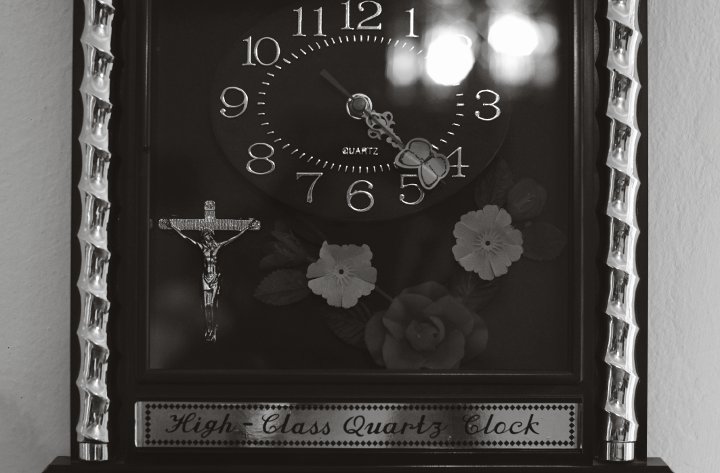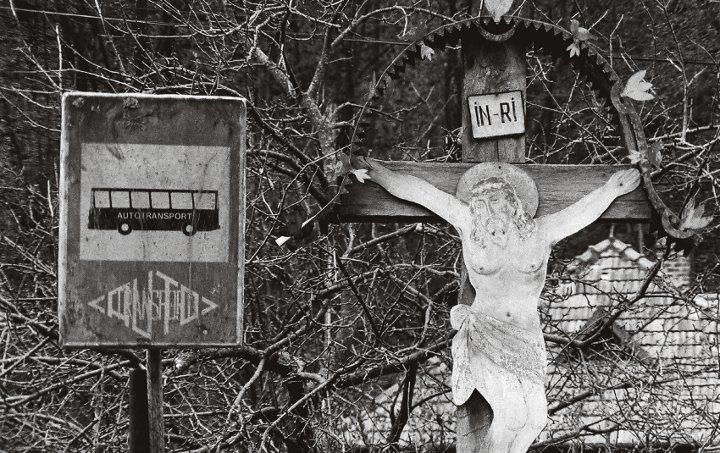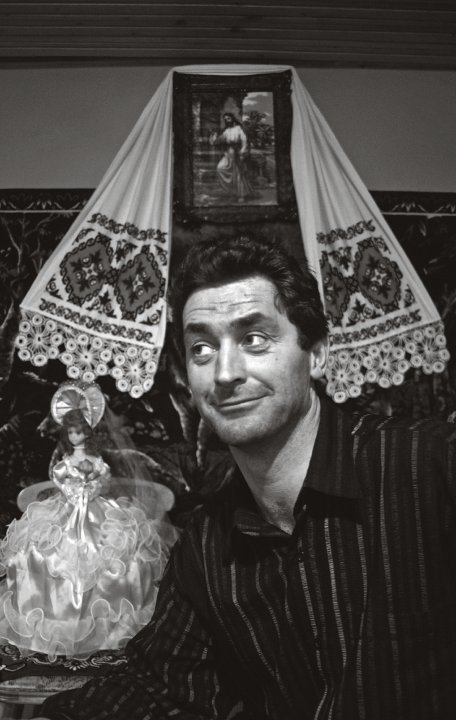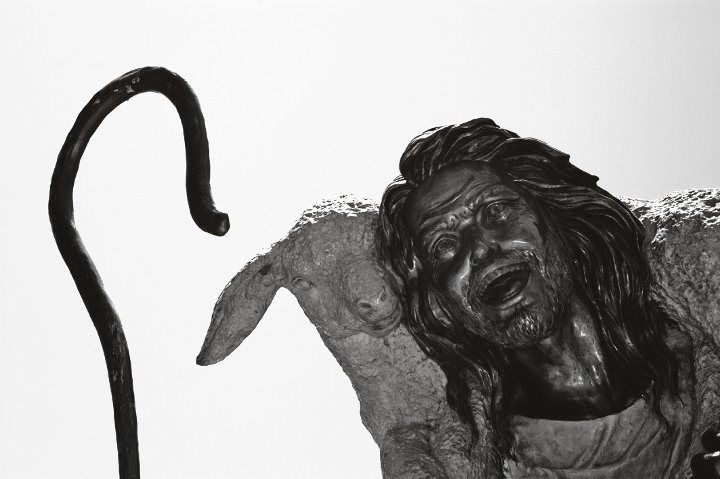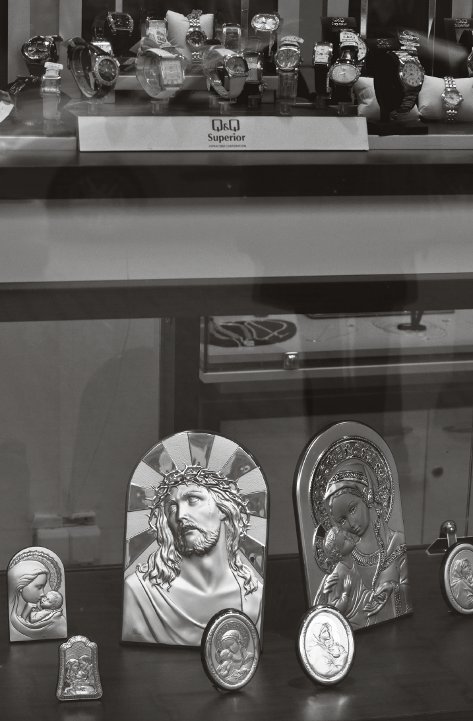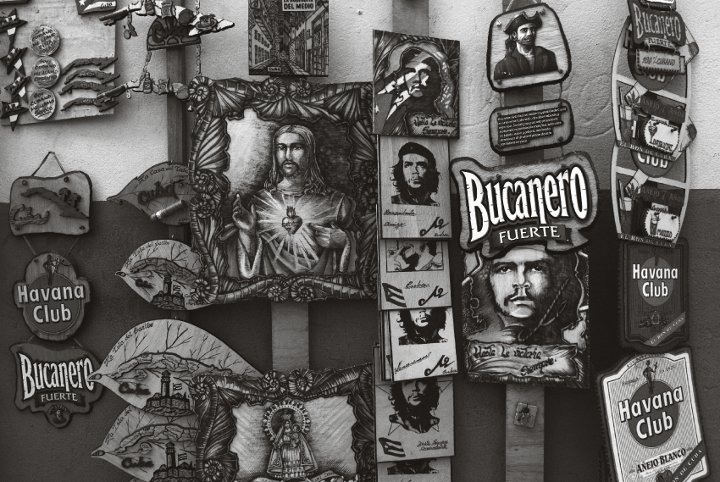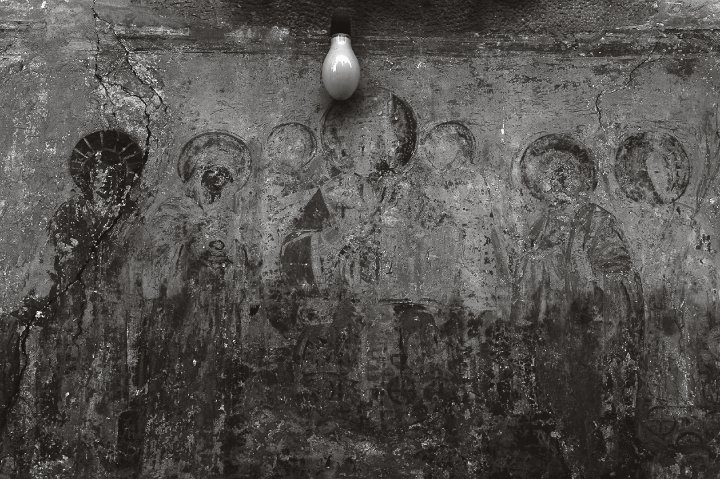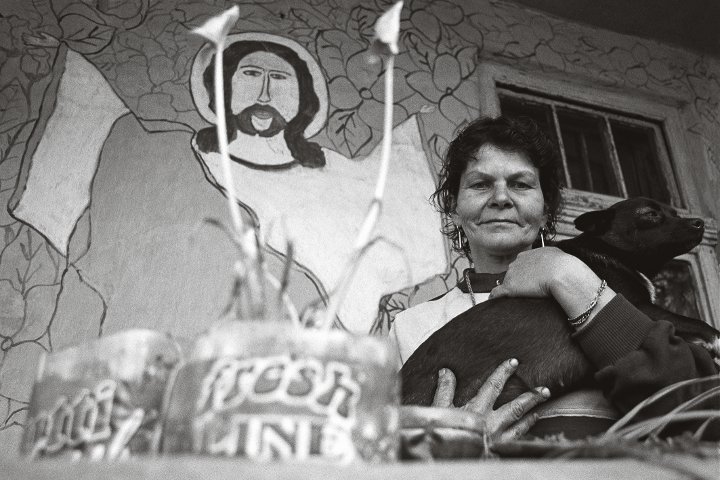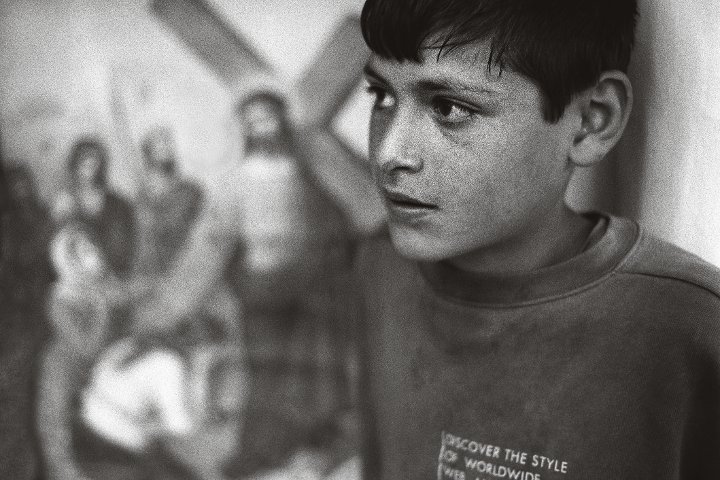Voicu Bojan
Proiectul Iisus / Jesus Project / Jézus terv
Editura Koinónia, 2009
translation: Dorothy Elford, Stuart Elford, fordította: Vallasek Júlia, Daray Erzsébet
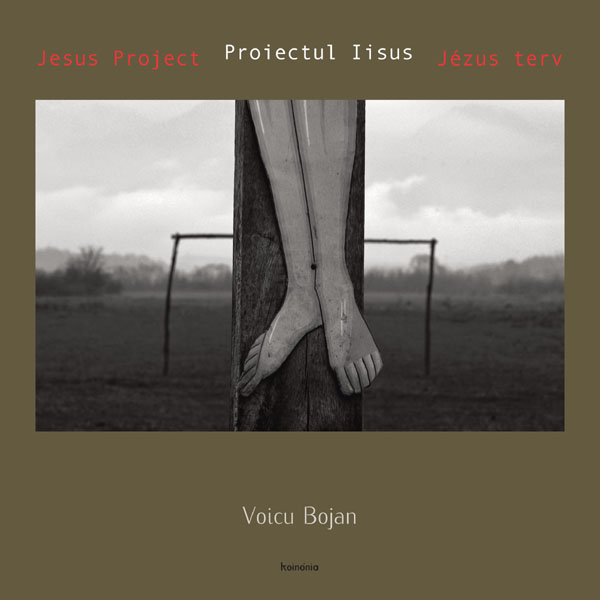
*****
Proiectul Iisus
Un Iisus al contextelor: al religiosului, al mundanului, al derizoriului. Un ready made object exhibat în piaţa de vechituri. Un construct după chipul şi asemănarea noastră. Un bun comun tot mai golit de sens. La ce bun să-l mai cauţi?Proiectul Iisus / Jesus Project / Jézus terv
Editura Koinónia, 2009
translation: Dorothy Elford, Stuart Elford, fordította: Vallasek Júlia, Daray Erzsébet

*****
Proiectul Iisus
Totul a început în ziua în care un bărbat necunoscut, purtând o bască pe cap şi o jachetă maro de fâş cu mânecile cam scurte şi-a făcut o cruce în faţa sinagogii de pe strada Horea din Cluj. Chiar aşa - a ridicat privirea spre cele două turle de tablă gri, murdare şi incerte aidoma cerului sătul de iarna prea lungă. Ţintea cu ochii undeva în sus, căutând parcă spre şarpele de aramă înălţat de Moise în pustie. Şi-a dat jos basca încet, cu mâna stângă, scoţând la iveală un păr rar, lipit perfect de cap, apoi cu dreapta a tras o cruce ca la manualul de religie, mare şi solemnă. Şi a plecat. Cu basca-n mână.
Sau poate a început în ziua în care m-am trezit cu un email de la Jesus. Era vorba de cineva care, bănuiesc, doar semna Jesus şi care, de fapt, încerca să-mi vândă ceva. La superofertă, normal. Mesajul a sfârşit în junk mail, după o clipă de ezitare în care m-am gândit: dar dacă o fi adevăratul Iisus? A doua venire a lui Mesia, cea despre care vorbeşte Scriptura, de ce n-ar putea avea loc pe internet? Discret, printr-un mesaj pe email trimis aleşilor. Doar se spune că nimeni nu ştie nici ceasul acela, nici forma venirii. Am respins iute ideea, care s-a dus uşurel pe apa Sâmbetei odată cu o duşcă mare de cafea cu lapte şi puţină miere.
Ori o fi pornit totul chiar în dimineaţa când un martor al lui Iehova mi-a pus în mână, la pachet cu un zâmbet tâmp, revista Treziţi-vă!, având pe copertă un Iisus straniu atârnând nu de o cruce, ci legat strâns cu o frânghie, având braţele întinse în sus, prinse de un lemn vertical. Avea o figură de actor american şi dramatismul scenei părea curată butaforie de Hollywood - un Charlton Heston capturat de indieni, cu scalpul încă la purtător, privind vag încrezător în viitor. În fundal, nişte nori de furtună, deloc optimişti. Deşi eram cam inert, sub efectul copertei Treziţi-vă! m-am trezit brusc şi am grăbit pasul.
Adevărul e că nici nu mai ştiu bine ziua când am decis că trebuie să-l caut pe adevăratul Iisus, acest personaj străin şi totuşi familiar de care ne lovim mereu pe la răspântii de drum, pe care îl zărim cu coada ochiului ici colo: în vitrinele magazinelor de suveniruri, la ţară, prin biserici şi cimitire, agăţat de lănţişorul aurit al unei fete, care doarme legănat în tren. Sau reactivat de gesturile unor pasageri din autobuz care îşi fac cruce, ca la comandă, tocmai când şoferul bagă în a treia, în dreptul catedralei.
Mă întreb pe unde o fi azi de găsit acest Iisus rătăcit printre noi? Un ready-made object, cu o faţă construită după chipul şi înfăţişarea noastră, mai mereu răstignit, deşi la fiecare Paşti ni se reaminteşte că femeile au găsit mormântul gol. Poate fi de găsit azi amestecat undeva prin mulţime, la bătaia anuală pe apa sfinţită de la gerul Bobotezei? Sau pe unde o fi când are loc o mega-evanghelizare pe un stadion şi un pastor american cu dinţi perfecţi tună ceva despre sfârşitul lumii? Sau când moaştele Sfintei X sunt plimbate de colo-colo cu limuzina printr-un cartier de blocuri? Sau la deschiderea de an şcolar când un sobor de preoţi bolboroseşte ceva de neînţeles în zumzet de elevi aşezaţi frumos în careu, dar care stau cu spatele, sporovăiesc de prin vacanţă şi îşi fac poze, doar ca să-şi prezinte unii altora ultimele modele de telefoane mobile?
Sau pe unde s-o fi ascunzând de fapt Iisus în luna decembrie - când devine strategia perfectă de marketing? În varianta lui păşunist-pastorală, e brusc reanimat pe toate planurile, semănând pe undeva cu instalaţia de brad la care nu te gândeşti tot restul anului, dar te bucuri când vezi că se mai aprinde. Personajul nostru, altfel enigmatic, devine brusc practic, funcţional - generează emoţii intense, naşte efluvii de bunătate, stoarce lacrimi ce cad pe bărbi false de moşi, împacă familii dezbinate prin reality show-uri.
Apoi, odată cu ultimele artificii din noaptea de Revelion, acest Iisus bucălat, acum proaspăt reîncărcat, aburit de respiraţia vitelor din ilustratele primite prin poştă, minunată strategie de marketing a Sărbătorilor, recipient al tuturor semnelor crucilor corect executate, subiect al colindelor, se efasează, se retrage din lume şi dispare cam până primăvara. E un fel de realitate inconsistentă ce aparţine lumii, dar, vorba Scripturii, nu prea se potriveşte chipului ei. De fapt, şi în Evanghelii face la fel, asta e un fel de marcă a lui - când apare, când dispare. La un moment dat, culmea!, dispare până şi din propriul său mormânt. Devine o absenţă localizată destul de vag, undeva dincolo de nori. Cu toate acestea, semnul lui nobiliar rămâne obsedanta cruce - acest scandal necesar pentru evrei şi incomod pentru alte neamuri. O necesitate teologică jenantă în procesul mântuirii, care azi, într-o lume emancipată, trebuie trecută iute cu vederea.
Aşadar, de Paşti, Iisus reapare pe firmamentul conştiinţelor cetăţenilor sau, cu alte cuvinte, re-învie. În Ardeal, li se arată mai întâi fraţilor credincioşi maghiari şi celor catolici. Unii chiar organizează procesiuni de purtare a crucii, se mimează răstigniri din acelea cu sutaşi romani cu mături roşii în cap şi tot tacâmul. La români, după noaptea chemării spre a lua lumină urmează nenumărate mese festive. Sfârşitul postului e sinonim cu dezlegarea la colici biliare şi la o veselie nestăpânită. Bărbaţii din Ardeal, în costume sobre, umblă la udat fetele şi se întorc acasă dezlegaţi la cravată şi cam băuţi. Pe mese, pe lângă miei, drob, vin şi cozonaci, feluriţi iepuri ţanţoşi se amestecă la grămadă cu ouă roşii şi ouă kinder cu surprize. Pe micile ecrane, crăciuniţele semi-nude fac acum loc iepuraşelor playboy. În fine, totul se termină cu bine, a treia zi, după Scripturi. Şi Iisus dispare iar din decor, de data asta pentru o bucată mai lungă de vreme, până într-o dimineaţă ceţoasă de noiembrie, când angajaţii de la supermarketuri primesc ordin să umple iar rafturile cu globuri.
Cum ziceam, m-am hotărât într-o bună zi să-l caut pe adevăratul Iisus. L-am găsit pe te miri unde. L-am şi pierdut de o grămadă de ori, doar ca să-l găsesc iar, ca pe un buletin ce nu stă defel locului în portmoneu. Chiar şi atunci când crezi că l-ai pierdut pentru totdeauna sună un binevoitor la uşă să ţi-l aducă. Te mai şi uiţi la poză să vezi dacă eşti tu. Ca să-l găsesc azi pe acest Iisus rătăcitor am citit o seamă de cărţi, am făcut grămadă de fotografii, majoritatea proaste, am îngenuncheat pe la miezonoptici în toiul iernii la o mănăstire, am reconstruit şi fotografiat pe scena unui teatru Cina cea de taină după Leonardo da Vinci cu vagabonzii de la un azil de noapte în rol de apostoli şi cu un Iisus de împrumut, fost proprietar de cârciumă. A fost o cină pe cinste, cu pui fripţi, struguri, pâine şi vin.
Ca să-l găsesc şi mai bine, am cutreierat o bună bucată de lume, am dat de el prin aeroporturi, gări, agăţat de oglinzi retrovizoare în maşinile de ocazie care m-au purtat aiurea prin deşerturi în Asia sau câmpuri de trestie de zahăr în Caraibe. L-am văzut cu coada ochiului în Las Vegas, când tocmai se crăpa de ziuă, atârnând mare şi greu la gâtul unei prostituate care mergea agale, pe tocurile ei înalte, spre casă. Ba chiar am dat nas în nas cu el şi în cel mai paradoxal loc cu putinţă - la baza unei pârtii de schi pe care coboram vijelios, undeva în Tirol.
A kontextusok Jézusa: a vallásosé, a mondéné, a nevetségesé. Ócskapiacra kitett ready made object. A mi képünkre és hasonlatosságunkra gyúrva. Egyre értelmetlenebbé váló közös tulajdon. Mi értelme keresni?
Az egész azon a napon kezdődött, amikor a micisapkás, kissé rövid ujjú, barna viharkabátot viselő, ismeretlen férfi keresztet vetett Kolozsváron, a Horea úti zsinagóga előtt. Ahogy mondom, felnézett a két szürke bádogtoronyra, piszkosak voltak és bizonytalanok, akár a hosszú télbe belefáradt ég. Valahova felfele emelte tekintetét, mintha a Mózes által, a pusztában égnek emelt bronzkígyót keresné. Bal kézzel lassan levette a sapkáját, szabadon hagyva ritkás, fejéhez simuló haját, jobbjával pedig úgy vetett keresztet, ahogy a vallási könyvekben előírják, széles mozdulattal, ünnepélyesen. Azzal elment. Kezében a sapkával.
Vagy talán azon a napon kezdődött, amelyen váratlanul emailt kaptam Jézustól. Feltételezem, olyan valakiről van szó, aki Jézusként írta alá, voltaképpen eladni akart nekem valamit. Persze akciósan. Az üzenet a junk mailek közt végezte, noha egy pillanatig tétováztam: hátha az igazi Jézusról van szó? A Messiás második eljövetele, amelyről az Írás beszél, miért ne mehetne végbe az interneten? Diszkréten, a kiválasztottakhoz eljuttatott email formájában. Ámbár azt mondják, sem az órát, sem az eljövetel módját nem tudhatja senki. Egy nagy bögre mézzel édesített tejeskávé után gyorsan elhessegettem a gondolatot, elvitte a víz.
Vagy azon a reggelen indult az egész, amikor Jehova egyik tanúja ostoba mosollyal a markomba nyomta az Ébredjetek! egy számát, a borítóján furcsa, nem keresztről függő, hanem karjait magasba emelő, függőleges oszlophoz szorosan odakötözött Jézussal. Amerikai színésznek látszott, a jelenet drámaisága sima hollywoodi bohóckodásnak tűnt: az indiánok által elfogott Charles Heston, a skalp még a viselőnél, amint ködös magabiztossággal tekint a jövő felé. Háttérben néhány, cseppet sem optimista hatást keltő viharfelhő. Ámbár elég kába voltam, az Ébredjetek! borítójának hatására hirtelen magamhoz tértem, és sietni kezdtem.
Az az igazság, már nem is emlékszem a napra, amelyen eldöntöttem, meg kell keresnem az igazi Jézust, ezt az idegen, mégis ismerős figurát, akibe mindig útkereszteződéseknél ütközünk, akit a szemünk sarkából pillantunk meg, hol itt, hol ott, emléktárgyakat árusító boltok kirakatában, falun, templomokban és temetőkben, egy vonaton szendergő lány aranyláncára függesztve. Vagy akit felidéz egyes buszon utazók gesztusa, ahogy mintegy vezényszóra vetik a keresztet, pont akkor, amikor a katedrális mellett a sofőr hármasba vált.
Vajon ma hol lehet megtalálni ezt a köztünk tévelygő Jézust? Ready made object, a mi képünkre és hasonlatosságunkra készítve, mindig megfeszítetten, noha minden húsvétkor eszünkbe juttatják, hogy az asszonyok üresen találták a sírt. Ott bujkálhat valahol a Vízkereszt jeges vizében évente megmártózó tömegben? Hol lehet például akkor, amikor mega-evangelizálás zajlik egy sportcsarnokban, és egy tökéletes fogsorú amerikai hittérítő a világvégéről mennydörög valamit? Vagy amikor Szent X maradványait limuzinban fel-le sétáltatják egy tömbháznegyedben? Vagy a tanévnyitón, amikor papok serege dünnyög érthetetlenül a diákok susogása közepette, akiket szépen négyszögbe tereltek, de háttal állnak, a szünidőről fecsegnek, és fényképeznek, csak hogy bemutassák egymásnak a legújabb mobiltelefon modelleket?
Vagy hol rejtőzhet decemberben, amikor tökéletes marketing stratégia lesz belőle? Békés pásztori alakja hirtelen minden szinten életre kel, kissé a karácsonyfa égősorához hasonlít, amely egy évig eszedbe sem jut, de örülsz, amikor látod, hogy még kigyúlnak rajta a fények. Egyébként titokzatos szereplőnk hirtelen gyakorlatiassá, funkcionálissá válik, erős érzelmeket gerjeszt, jóságözönt kelt, hamis Mikulás-szakállra hulló könnyeket fakaszt, és családokat egyesít újra a reality show-kban.
Aztán a szilveszter éjszaka utolsó tűzijátékaival ez a pufók arcú, frissen feltöltött Jézus, akit párába von a képes levelezőlapok marháinak lehelete (milyen kitűnő ünnepi marketing-stratégia), az összes helyesen vetett kereszt kútfeje, a karácsonyi énekek témája meglép, visszahúzódik, és úgy tavaszig eltűnik. Afféle tartalmatlan valóság ez, amely a világé, de az Írás szavával élve, nem az ő képére és hasonlatosságára készült. Amúgy az Evangéliumokban is így tesz, afféle védjegye ez, hol feltűnik, hol pedig eltűnik. Egy adott ponton, és ez már mindennek a teteje, a saját sírjából is eltűnik. Ködösen, valahol a felhők közt fellelhető hiány lesz belőle. Megkülönböztető jele mégis a rögeszmésen visszatérő kereszt, ez a zsidók számára elengedhetetlen, a többi nép számára kínos botrány. A megváltás folyamatának kínos teológiai szükségszerűsége, amelyet ma, ebben az emancipált világban sürgősen az asztal alá kell seperni.
Húsvétkor tehát Jézus ismét feltűnik a polgárok tudatának egén, más szóval feltámad. Erdélyben először a magyar hívőknek és a katolikusoknak mutatkozik meg. Egyesek körmeneteket rendeznek, előadják a keresztre feszítés történetét, vannak benne római századosok, piros seprűvel a fejükön, és minden más. A románoknál a fénygyújtás éjszakája után egymást érik az ünnepi lakomák. A böjt vége egyet jelent az eperohamok kezdetével, és a fékevesztett jókedvvel. Erdélyben a komor öltönyt viselő férfiak útnak erednek meglocsolni a lányokat, és meglazított nyakkendővel, kissé pityókosan térnek haza. Az asztalon ott a sült, a bárányaprólék, bor, kalács, különböző hetyke nyulak keverednek a piros tojással és a meglepetést tartogató Kindertojásokkal. A képernyőkön a félmeztelen karácsonyi manólányok átadják helyüket a playboy nyusziknak. Végül harmadnapon, ahogy az Írás is mondja, minden jól végződik. Jézus pedig ismét eltűnik a díszletek közül, ezúttal hosszabb időre, egy ködös novemberi reggelig, amikor a szupermarket alkalmazottjai azt az utasítást kapják, hogy ismét töltsék fel karácsonyfadíszekkel a polcokat.
Ahogy mondtam tehát, egy szép napon elhatároztam, hogy megkeresem az igazi Jézust. Meglepő helyeken akadtam rá. Számtalanszor el is veszítettem, hogy aztán újra megtaláljam, mint egy személyi igazolványt, amely sehogy sem marad meg az ember pénztárcájában. Amikor azt hinnéd, végképp elveszítetted, becsenget egy jótét lélek az ajtón, és hozza. Még meg is nézed a fényképet, tényleg te vagy rajta? Ahhoz, hogy ezt a tévelygő Jézust megtalálhassam, rengeteg könyvet olvastam, egy csomó fényképet készítettem, többségük rossz, térdeltem tél közepén, éjfélkor egy kolostorban, színpadon rekonstruáltam majd lefényképeztem Leonardo utolsó vacsoráját, egy éjjeli menedékhely csavargói alakították az apostolokat, a kölcsön-Jézus pedig hajdan kocsmatulajdonos volt. Tisztes lakoma volt, sült csirkével, szőlővel, kenyérrel, borral.
Hogy ráakadhassak bejártam a világ jó részét, repülőtereken, állomásokon találkoztam vele, alkalmi fuvarozó autók visszapillantó tükrére akasztva, amelyek összevissza hurcoltak engem ázsiai sivatagokon keresztül, karib-szigeti cukornád ültetvények között. Las Vegasban a szemem sarkából pillantottam meg, amikor éppen hajnalodott, súlyosan, testesen lógott egy prostituált nyakában, aki magas cipősarkain lassan tipegett hazafelé. Sőt, a lehető legparadoxabb helyen is beleütköztem - valahol Tirolban, egy sípálya alján, amelyen végigszáguldottam.
A Jesus of different contexts: religious, worldly, banal. A ready-made object on display at a flea market. A construct in our image and likeness. A piece of public property that is becoming ever more emptied of meaning. What is the use of continuing to look for him?
It all began on the day when a man I didn't know, a man in a beret and a brown waterproof jacket, with sleeves somewhat on the short side, made the sign of the cross in front of the synagogue on Horea Street in Cluj. Just like that. He looked up at its two grey, sheet-metal clad turrets, dirty and dubious, like a sky that had had enough of a winter that had gone on too long. His gaze was directed 'up there' somewhere, as if looking for the bronze serpent that Moses had lifted up in the desert. He removed his beret slowly with his left hand, revealing straggly hair plastered smoothly across his head. Then, using his right, hand he made a big, solemn sign of the cross - just like in a religious textbook. And then he left. Beret still in hand.
Or perhaps it started on the day when I found myself reading an email from Jesus. It was a case of someone who, I imagine, merely signed himself 'Jesus' and who was, in fact, trying to sell me something. At an amazingly attractive price, naturally. The message ended up in my junk mail folder, after a moment of hesitation in which I thought, what if it were from the real Jesus? The second coming of the Messiah that Scripture speaks of - why shouldn't it take place over the internet? Discreetly, by means of an email sent to the elect. Only it's said that no one knows either the time or the manner of his coming. I swiftly rejected the idea and it was borne away on a stream of consciousness, with some help from a big gulp of milky coffee sweetened with a bit of honey.
Or again, it may all have started on the morning when a Jehovah's Witness gave me an idiotic smile and a copy of Awake! Its cover showed an alien Jesus, not hanging on a cross but tightly bound with a rope, his arms stretched above his head, tied to a post. His face was that of an American actor and the drama of the scene was pure Hollywood - a Charlton Heston captured by Red Indians, scalp still in place, gazing into the future with a vague expression of confidence. Background: storm clouds. Outlook: far from hopeful. I hadn't been walking all that fast, but the cover of Awake! woke me up with a start and I quickened my step.
The truth is that even I am no longer sure of when exactly it was that I decided I needed to look for the real Jesus, this foreign and yet familiar character whom we are constantly bumping into at crossroads, whom we glimpse here and there in souvenir shop windows, in country churches and cemeteries, swinging from a golden chain around the neck of a schoolgirl who has fallen asleep on the train. Or triggered by bus passengers who, as if to order, make the sign of the cross just when the driver shifts into third gear as he passes the cathedral.
I wonder where this Jesus who wanders among us can be found today? A ready-made object with a face modelled in conformity to our image and likeness, always on the Cross, although we are reminded every Easter that the women found the tomb empty. Could he be hiding somewhere in the crowd during the annual beating of the consecrated waters at the time of the Twelfth Night frost? Or where is he when there is a mega evangelistic event in some stadium and a foreign pastor, with perfect teeth, thunders out something about the end of the world? Or when the limousine-borne relics of Saint X are paraded up and down the streets in a neighbourhood of apartment blocks? Or during the official opening of the new school year, when a fraternity of priests mumble something unintelligible against the background hum of schoolchildren seated in a tidy square, all turning round to chat about their holiday and to take photos, 'incidentally' showing off their new state-of-the-art cell phones?
And where might Jesus be hiding in December, when he becomes the perfect marketing tool? In his 'sheep may safely graze' variant, he is suddenly and everywhere resuscitated. He is somewhat like a set of Christmas tree lights - you don't spare them a thought for the rest of the year, but you are happy when you see them switched on once again. This Jesus, who is usually so enigmatic, immediately becomes practical and functional, arousing intense emotions, producing floods of seasonal cheer, wiping away the tears that fall on the false beards of Father Christmases, and reconciling estranged families on every TV reality show.
Then, the second the last of the New Year's fireworks have sputtered out, this freshly reloaded, chubby-cheeked Jesus, flushed by the warm breath of the cattle on the Christmas cards, the dream of every ad-man's festive season, the recipient of all properly executed signs of the cross, the theme of the carols, effaces himself, withdraws from the world and disappears until Spring. He is a kind of on-off reality which belongs to the world but, in the words of Scripture, doesn't quite conform to it. In fact, he does the same thing even in the Gospels. It's a kind of trademark of his - now you see him, now you don't. At one point, to top it all, he even vanishes from his own tomb. He becomes an absence that is only rather vaguely localised, somewhere beyond the clouds. Yet, his badge of nobility is still that troubling cross, that stumbling-block that was necessary for the Jews and inconvenient for other peoples. An offensive theological necessity in the matter of salvation which today, in a liberated world, has to be passed over as swiftly as possible.
And so, at Easter, Jesus reappears in the firmament of the Romanian consciousness or, in other words, comes to life again. In Transylvania, he shows himself first to the Hungarian and Catholic believers. Some of them even lay on cross-bearing processions and there are Crucifixion mimes, the kind with Roman centurions sporting red brush helmets and all that stuff. For the Romanian believers, the night when they are summoned to church to receive the light is followed by countless festive meals. The end of Lent is synonymous with a release from the strictures of fasting into all the joys of unrestrained good cheer accompanied by serious attacks of indigestion. The men of Transylvania don dark suits to go out and about in fulfilment of the custom of sprinkling water on the young girls, only to return home in their own state of release, their neckties loosened and somewhat the worse for wear. On the table, along with lamb, tripe, wine and brioche, all manner of jaunty rabbits make their appearance, jumbled together with traditional red-painted eggs and Kinder Surprise chocolate Easter eggs, each containing a novelty gift. On the small screen, the half-naked girls in Father Christmas costumes have now given way to Playboy bunnies. Finally, everything ends well, on the third day, according to Scripture. And Jesus vanishes from the scene once more, this time for a longer chunk of the year, until some foggy November morning when supermarket staff are instructed to stock the shelves with baubles once again.
As I said, I decided one fine day to search for the real Jesus. You'll be surprised at where I found him. I lost him many times as well, only to find him again, like an ID card that simply won't stay where it belongs in your wallet. Just when you think you've lost it for ever, a public-spirited citizen rings your doorbell and hands it back to you. You take a look at the photo to be sure that it's you. In order to find this wandering Jesus today, I read many books, took heaps of photographs (mostly bad ones), knelt in a monastery at midnight in the depths of winter, and even reconstructed Leonardo da Vinci's Last Supper on a theatre stage and photographed it, with tramps from a night shelter as the apostles. The borrowed Jesus was a onetime bar owner. It was an excellent dinner, with fried chicken, grapes, bread and wine.
In order to better find him, I criss-crossed a fair part of the world, running across him in airports and in stations. He swung from the rear-view mirror of secondhand cars that carried me through deserts in Asia or sugar cane plantations in the Caribbean. Once I saw him out of the corner of my eye in Las Vegas, just as day was breaking, hanging large and heavy around the throat of a prostitute as she sauntered homewards on her high heels. I even came face to face with him in the most paradoxical place possible - at the bottom of a ski slope, somewhere in the Tyrol, which I was descending like a whirlwind.
Vezi fragmentul de mai sus în format pdf aici.
